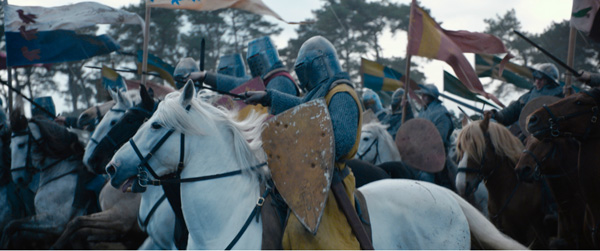
Dramatic film 'Outlaw King' is the story of 14th century Scottish king, warrior and hero Robert the Bruce, who leads his people in a passionate battle for independence against the much larger, more sophisticated English army. Director David Mackenzie shot on location in Scotland, aiming to make every aspect of the film, made for Netflix, as historically accurate as possible. Working with him, production VFX Supervisor Alex Bicknell and Method Studios achieved the desired authenticity through invisible visual effects that often needed a complex approach.
Having worked with Method a few years earlier on 'Mad Max: Fury Road', Alex chose to work with their team again. During production, Method's VFX Supervisor Dan Bethell joined Alex and the production on set in Scotland to work out the more challenging sequences including the Battle of Loudoun Hill at the story's climax.
After the shoot, Method’s team of 180 artists then spent nine months digitally augmenting and extending castle locations and environments, enhancing crowds and creating CG horses, fire, gore and other elements. In each case, historical accuracy in materials, agricultural elements, weaponry and all details was their top priority.
“David and Alex had a great understanding of how visual effects could enhance the historical accuracy and increase the believability for certain sequences when we couldn’t physically capture everything as it was in the 1300s,” said Dan. “Because so much was shot on location, instead of on a blue screen stage, our tracking and rotoscoping departments, working in 3d Equalizer to track the shots and Nuke for roto. really had their work cut out for them, and gave us an ideal foundation for the rest of the effects work.”
Capturing History
The production art department had completed a huge amount of historical research and thoroughly photographed each location for reference material. “Apart from the traditional reference we captured on set, the most useful and inspirational material was gathered from historical documents by the production art department before the shoot,” Dan said. “They had found period sketches of castles, maps of cities drawn at the time and even flag heraldry - everything was researched in minute detail. This formed a great basis for the authenticity of our VFX, because everything from set design to costumes had already been established in a relentless pursuit of accuracy.
“When capturing reference photography we used every trick in the book, from comprehensive photogrammetry of sets and characters - even the horses got in the photogrammetry booth – lidar scans of castles to thousands of texture reference photographs and, of course, HDRI. Everything we could capture on location would give us more help in post production, and hopping back to Scotland because we'd forgotten to photograph a hillside wasn't going to be an option.”

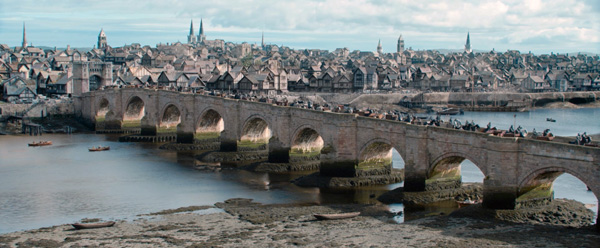
Beyond the visual reference, Dan's role on set involved gathering context for the scenes, and the reasons why things were shot in a certain way. Often, just a casual conversation with the director at the monitors was what was the most insightful, so that became the key information to carry into post.
“I often took on the VFX Supervision for the second unit, so I got a good understanding of the larger action pieces in the Loudoun Hill battle - the film's climax - and how they should all come together in story terms for the battle to develop. Occasionally I got to influence how things were shot, but mainly our philosophy was to capture as much of the amazing practical SFX and stunt action as we could in camera, in order to design the VFX to complement and support the photography.”
Flexible Final Renders
Because set extensions were such an important part of their work, the biggest development for Dan on this project was Method's move from traditional digital matte painting techniques for large environments to using full 3D renders with fully modelled and textured 3D assets. This change was made possible through the use of Clarisse, look development, set-dressing, lighting and rendering software that allows artists to work interactively on final renders.
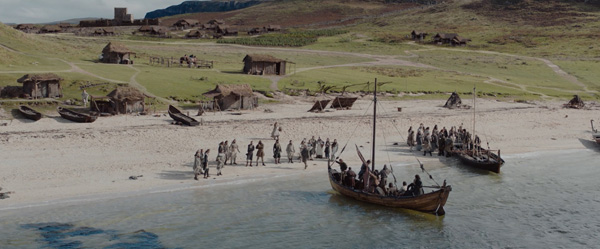
Dan said, “We could populate and render environments, quickly and with an incredible amount of detail, without having to worry at all about the geometric complexity - Clarisse just rendered whatever we threw at it. Combined with some advances in procedural texturing and our use of Substance texture tools, we produced high quality digital environments in a much shorter time. Having a fully 3D scene also gave us more flexibility – we could render the same environment across multiple shots as necessary, from different camera positions and in different lighting conditions.”
English Invasion
During the final climactic sequence, the Battle of Loudoun Hill, the Scottish army of about 600 foot soldiers uses their knowledge of the local countryside to defeat the invading English army of 5,000 soldiers on horseback. On set, about 300 extras and 40 horses were filmed practically, which Method augmented with digital soldiers and horses.
For the crowd work, Method artists built digital soldiers for both the Scottish and English armies, with full armour and animations including archers firing arrows, close-up combat with swords and cavalry. Again, the thorough research that Method’s art department and the production design team was critical to ensuring that all materials for clothing and armour, flags for clans and nobility, materials and layout for castles, and environmental elements were historically accurate. Since those early days, many species of trees and plants have been introduced to Scotland that had to be removed from the plates, and expansions have been made to castle locations that had to be restored to a form consistent with the period.
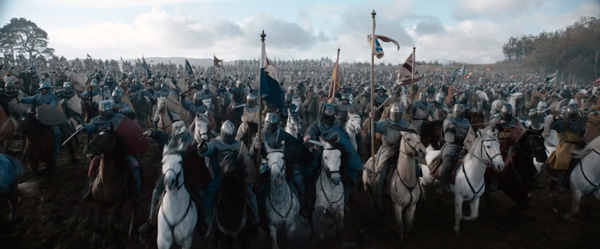
Rallying the Troops
They shot quite a few elements of various crowds on bluescreen, but these were mostly used toward the end of the battle, when the Scots are looking on as Robert and Edward fight in the mud. However, for the majority of battle shots of intense action, a CG process was preferable. Using photographic reference and photogrammetry captured from set, they created a wide variety of both Scots and English CG soldiers, including their horses, armour and weapons. Maya was used for creature modelling, rigging, muscles, animation and skin/secondary simulation. Houdini handled all aspects of crowds and FX.
“As long as we had a digital camera for a given shot, adding our extra soldiers and horses to the background as individuals was relatively straightforward and much more believable, because we could control the lighting and integration better than we could with photographed elements,” Dan said.
“For me, one of the most successful approaches to these sequences was the use of motion capture to add subtle, complex motion to the crowd. Matt Everitt, our animation supervisor, and I spent a couple of days capturing a variety of motions from hero action vignettes, to background motions of men standing around bored. Oh, and we captured a fair share of cheering motions for the end of the battle and a few drunk animations for the Glasgow docks earlier in the film!”
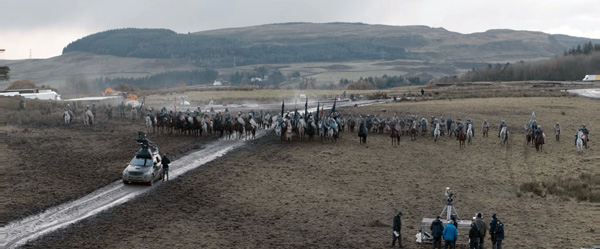
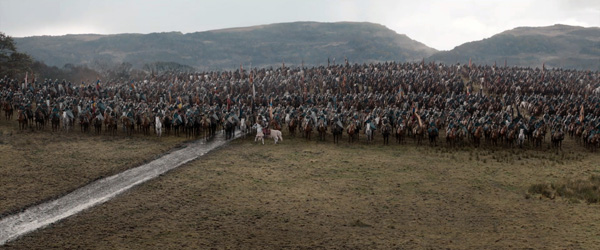
Procedural Variation
Dan, feeling that variation is absolutely essential when creating believable crowds, said they strove to add variation procedurally as far as possible to all levels of the work. This included a procedural costuming set-up that gave each agent a different combination of clothing and props – taking care to keep English and Scottish costumes completely separate - procedural blood and mud layered on top of the base textures, and very subtle scale variations for agents.
“A small variation in, say, head size between agents can quickly break the visual monotony that makes them all look identical. We even had a number of beards that could be procedurally instanced onto the Scots,” he said. “The shots in which the English stand stationary at the top of the battlefield were very problematic initially until we added variation - there were so many identical soldiers of the same height, the whole army ended up looking like a carpet. We made heavy use of Substance Painter and Substance Designer. Not only the quality of materials, but the procedural variation we could achieve, was invaluable for selling the realism.”
“The soldiers and their various bits of armour and weaponry, were all chosen automatically by our crowd system. For some specific shots I would tell artists which particular type I needed, archers for example, but mostly I would just let the procedural variation system do its thing. Of course, sometimes such systems go wrong – we had a few humorous moments when everyone ended up looking the same, or when all the agents lost their trousers.
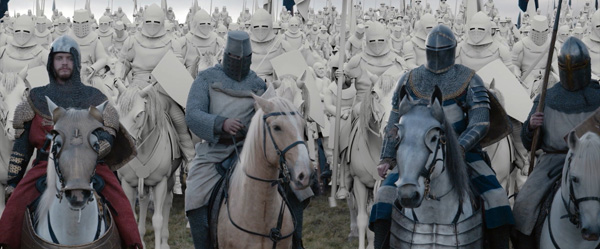
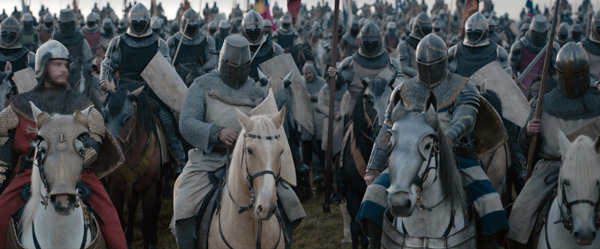
For the horses, the artists began with a strong foundation of experience from Method’s cavalry and combat VFX work on the 'Battle of the Bastards' episode of 'Game of Thrones'. Tailoring their approach for this project, artists visited a local stable and referenced Dan’s on-set photography to build their CG horses with fully rigged musculature and sliding skin, and equipped with authentic tack and saddles.
“Level of detail was handled at render time by our fantastic crowd-rendering plugin for PRMan written in-house by Chris Bone. It was incredible to be able to render that many agents - complete with chainmail armour, clothing, and horses with tack and hair - all in one pass. Pixar's Renderman rendered the vast majority of the work, including all the crowd shots. A couple of exceptions were Clarisse, as mentioned, for the big environments, and Mantra for some heavy FX work we did in Houdini. By utilising Katana and streamlining our workflow we could light and render a huge number of shots in PRMan with a relatively small team, and without compromising the quality of the final image.”
Nonlinear Battle
Meanwhile, Dan worked with the production team while David Mackenzie and editor Jake Roberts nailed down the story beats of the battle. “This sequence was quite unusual for VFX – typically it’s more of a linear process, but here the sequence had about 150 shots that were all in play at the same time, which made the action very dynamic as we worked out the story,” said Dan.

The film in this case was shot across two units, as is common, with the first unit handling the dialogue and principle characters, and the second unit handling the larger stunt and action performances. The battle was planned out and action beats were shot, although sometimes out of order, before they were conformed back into order in editorial.
“We’d work on a large bulk of shots simultaneously, and with each story tweak we’d have to implement that across all the relevant shots to maintain continuity. It was fun and collaborative, but definitely a different way of working than a more traditional VFX show. Our department leads needed to keep everything moving, at high enough quality and technical precision, to help David and Jake make decisions along the way.
“Clear communication was key. Alex Bicknell had a great understanding of the sequence and could always tell ahead of time if we were starting to stray from what the VFX needed to do. Spending time on set in Scotland with Alex and the director, David Mackenzie, was also really helpful. It gave a much greater insight into not only the story and sequence of events for the battle, but into David's intent for the characters and their motivations.”
Scottish weather
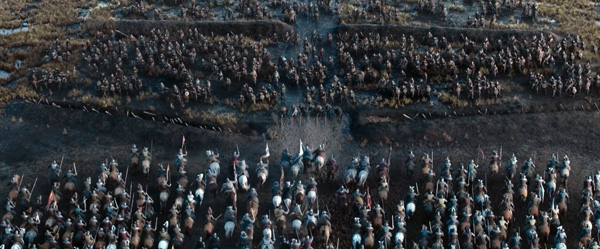
Dan always approaches VFX work with a story-first philosophy. But because effects were such an integral part of selling the action and developing the chaos of the battle, Dan had to give extra attention to making sure their work was helping editorially, rather than just making shots more confusing. He said, “Originally the battle was much longer, with the English attacking the Scots in multiple waves. Once the edit was trimmed and the English charge became one large effort, we had to adapt some of our crowd work to serve the new narrative.”
Other than a few story tweaks, probably the largest factor for continuity was the Scottish weather. During the shoot they experienced brilliant sunny days, and then some very rainy days but, with such a large crew and cast, couldn't always wait for the perfect conditions. This meant some shots ended up next to each other in the cut that contrasted noticeably. “We had to bring them in line to avoid confusing the audience, and ended up with a nice arc of weather, from the grey rainy start of the battle to the clearer sunset of the final battle between Robert and Edward,” said Dan. “It looks beautiful but there was quite a bit of work to bring it all together.”
Eight-minute, 8K Opener
In addition to the climactic battle, another notable sequence is the movie’s opening shot, for which the film's cinematographer Barry Ackroyd captured a continuous eight-minute take. Long, expressive, thoughtfully plotted shots are a trademark of his shooting style. Method's artists augmented this shot by adding crowds of English troops and extending their encampment, building the enormous 'War Wolf' trebuchet fired by King Edward, and replacing most of the environment including the legendary Stirling Castle, which is destroyed and set ablaze.
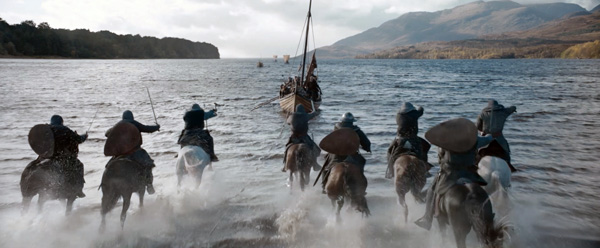
“Not only was it over eight minutes long, shot at 8K on the production's Panavision DXL, with interior and exterior locations, but from a VFX perspective it had a bit of everything. We added set extensions, environment work, crowds, destruction, all the way through to subtle fixes in compositing. Even though another version might have been easier on us in post, but it would never have looked as good - I think one of the reasons it is so successful is because the VFX compliments the photography, rather than driving it in the first place.
“Logistically, we broke the shot down into 12 sub-shots each with a varying level of complexity. We worked on the hardest sections first and once we had a handle on the foundations, we could roll out the work to the remaining parts. Finally, everything had to be compiled into the mega-shot you see in the film!
The War Wolf, Stirling Castle and its destruction were the most challenging aspects within all of this. Stirling Castle is a well-recognised, enduring symbol of Sctoland and getting the design right, and making it believable while destroying it was not an easy feat. As we were using Houdini for the destruction FX, atmospherics, fire and embers, we chose Mantra as renderer for these shots.” www.methodstudios.com


















